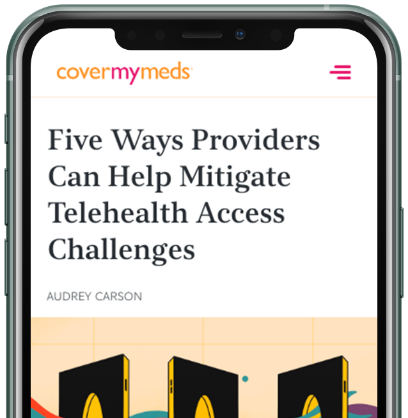Medicare, Medicaid and the Prior Authorization Process
Submitting a prior authorization (PA) request for a patient on Medicare or Medicaid? With an electronic solution, the process is the same regardless of your patients’ coverage type.

When it comes to the differences between three of the most common types of health coverage — commercial, Medicare and Medicaid — confusion is common. Questions range from “How do these problems affect prescription coverage?” to “What do these differences mean for completing prior authorization (PA) requests?” Confusion is amplified by the fact that not all healthcare staff manage PA requests every day.
Here’s the good news: An electronic PA (ePA) solution streamlines the PA process for every request, regardless of a patient’s coverage type. (A bit more on that later.)
So, What's Medicare?
Established in 1965, Medicare is a government insurance program that Americans become eligible for at age 65. The program is also available for those meeting certain disability criteria.
In 2019, Medicare spending grew 6.7 percent — to nearly $800 billion — or 21 percent of total national health spending.Medicare.gov (By contrast, private health insurance accounted for 31 percent of total national health spending in 2019.)Medicare.gov
The plan covers things like doctor’s visits, hospitalizations, home healthcare and, beginning in January 2006, prescription drugs.
The four most common parts of Medicare are:NHE Fact Sheet, 2020
- Part A: inpatient hospital coverage
- Part B: outpatient medical coverage
- Part C: also known as Medicare Advantage, an alternative way to receive Medicare benefits through a private sector payer
- Part D: medications
Medicare Part D covers most medications. However, patients can use Part B to cover therapy as well. Generally, Part B is used only to cover medications administered in conjunction with a procedure — or with the use of durable medical equipment (DME). Often, the managing plan has its own unique coverage criteria and a specific PA request form, detailing the medication’s use and administration — and whether patient coverage for said medication is under Part B or D.
Understanding Medicaid
Medicaid, unlike Medicare, is funded mutually by federal and state governments. Covering 70.6 million Americans as of September 2020,Medicaid.gov and expected to grow tremendously due to the COVID-19 pandemic, the program provides health coverage to eligible low-income adults, children, pregnant women and those with disabilities.Medicaid.gov
In 2019, Medicaid spending grew 2.9 percent — to nearly more than $613 billion — or 16 percent of total national health spending.NHE Fact Sheet, 2020
A patient covered by Medicaid can have one of two plans: Managed Medicaid or State Medicaid. Managed Medicaid plans are private enterprises that provide health benefits for individuals on the Medicaid program. These plans are compensated on a per-person rate for fulfilling the patient’s coverage.
State Medicaid plans are administered directly by the government of the state in which the patient resides. Because each state is responsible for its own Medicaid program, eligibility varies by state.
Like Medicare plans, each Medicaid plan has its own unique coverage criteria and PA request form to complete — and it’s important that providers and their staff find the right one for their patients.
Completing a PA Request for Any Plan
The less time spent managing PA, the faster patients get the medications they need, and integrated ePA solutions within EHRs can allow providers to submit PA requests at the point of prescribing. This results in patients receiving their medications an average of 13.2 days sooner, compared to requests started at the pharmacy.CoverMyMeds data on file, 2019
When using an ePA solution like CoverMyMeds to submit and manage prescription PA workload, the process for completing a medication PA request is the same for commercial, Medicare and Medicaid plans.
Many Medicare Part D and Medicaid plans have transitioned to an ePA format — meaning staff receive electronic determinations, often in real-time. By modernizing the process, plans with ePA capabilities are helping decrease administrative waste and save providers time.
A recent rule finalized by the Centers for Medicare & Medicaid Services (CMS), "Medicare Program; Secure Electronic Prior Authorization for Medicare Part D” is aimed at further streamlining the Medicare Part D PA process — and improving the sharing of data between payers and providers.
Another recent CMS rule — "Patient Protection and Affordable Care Act; Reducing Provider and Patient Burden by Improving Prior Authorization Processes, and Promoting Patients’ Electronic Access to Health Information for Medicaid Managed Care Plans…" — requires payers in Medicaid, CHIP and issuers of individual market qualified health plans on the federally facilitated exchange to build a patient-access application programming interface (API) for data exchange and PA. (Medicare Advantage plans are not included.) Information to be made available to patients includes the status of pending and active PA decisions.
It’s expected that both state and federal policy makers continue to advance not only PA but other patient access issues, such as price transparency. Innovators in the market will continue advancing toward interoperability, data liquidity and transparency in order to empower clinical and prescription decision support and access for patients to their needed medications.
For more about the impact of ePA on provider workload and patient access, check out CoverMyMeds’ 2021 Medication Access Report. Healthcare providers interested in learning more about a more efficient way to manage PA can learn more on our Solving Prior Authorization page.
The latest healthcare insights, floated right to your inbox.





